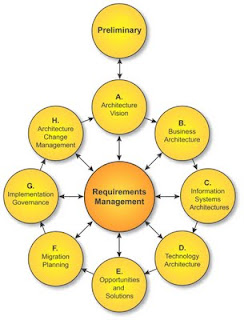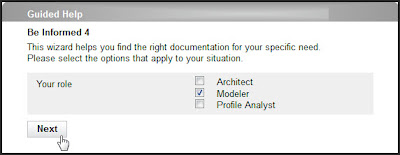Supporting how people do things
Just a few thoughts on the design of documentation. In my last blog I have introduced the idea of using a more goal-driven approach in documentation. To achieve a goal the user needs to perform
activities, make decisions, choose from options and learn about
something about the functionality of the product.
This approach might sound new, but it's origin goes back to the basics of user-centered design, as described by Donald Norman in his brilliant book "The Design of Everyday Things" (1988).
In his book, Norman describes how people do things with The Seven Stages of Action:
So what we try to achieve with our documentation is merely supporting users in reaching their goals. And what would be more natural than describing the activities they have to do and help them interpreting their context. A process-driven approach, describing every action within its context, would be ideal from this point of view. It would be the first step in creating smart user-centric documentation, that takes individual users by the hand and guides them towards their individual goals within their context.
However, to make this work we have to abandon our traditional print-oriented documentation approach and create smart documentation that guides individual users through the maze of actions, decisions and choices they have to make. Semantic technology gives us the tools and methods to create this smarter, user-centered type of documentation.
 The
STC Summit 2013 is probably the world's largest and most influential
conference for everyone working in the area of technical communication.
The Summit is packed with more than 80 sessions over the three full
workdays with topics covering all aspects of technical writing, editing,
project management, and publication production. It takes place 5-8 May
in Atlanta, Georgia.
The
STC Summit 2013 is probably the world's largest and most influential
conference for everyone working in the area of technical communication.
The Summit is packed with more than 80 sessions over the three full
workdays with topics covering all aspects of technical writing, editing,
project management, and publication production. It takes place 5-8 May
in Atlanta, Georgia.
A preliminary overview of the sessions can be found on:
http://summit.stc.org/program-info/program-overview/
This approach might sound new, but it's origin goes back to the basics of user-centered design, as described by Donald Norman in his brilliant book "The Design of Everyday Things" (1988).
In his book, Norman describes how people do things with The Seven Stages of Action:
- Forming a goal, for example: I want to watch a movie on my television
- Forming the intention, for example: I will turn on the DVD Player and the television
- Specifying an action: I will pick up the remote control and turn the DVD Player and television on
- Executing the action: Attempting to do the action
- Perceiving the state of the world: I look at the television screen
- Interpreting the state of the world: Can I see the movie on my television screen?
- Evaluating the outcome: If I can see the movie, I have succeeded. If I can't see the movie, I have to perform another action.
From goal-driven to process-driven
When we look at this 7 steps, we can quite easily plot the role of documentation in it.So what we try to achieve with our documentation is merely supporting users in reaching their goals. And what would be more natural than describing the activities they have to do and help them interpreting their context. A process-driven approach, describing every action within its context, would be ideal from this point of view. It would be the first step in creating smart user-centric documentation, that takes individual users by the hand and guides them towards their individual goals within their context.
However, to make this work we have to abandon our traditional print-oriented documentation approach and create smart documentation that guides individual users through the maze of actions, decisions and choices they have to make. Semantic technology gives us the tools and methods to create this smarter, user-centered type of documentation.
Follow me on my way to Atlanta
This process-driven approach to documentation is the central theme in my presentation at the STC Summit 2013 in Atlanta. During this session I will demonstrate how we can embed instructions in a process and make them actionable by using semantic technology.STC Summit 2013
 The
STC Summit 2013 is probably the world's largest and most influential
conference for everyone working in the area of technical communication.
The Summit is packed with more than 80 sessions over the three full
workdays with topics covering all aspects of technical writing, editing,
project management, and publication production. It takes place 5-8 May
in Atlanta, Georgia.
The
STC Summit 2013 is probably the world's largest and most influential
conference for everyone working in the area of technical communication.
The Summit is packed with more than 80 sessions over the three full
workdays with topics covering all aspects of technical writing, editing,
project management, and publication production. It takes place 5-8 May
in Atlanta, Georgia. A preliminary overview of the sessions can be found on:
http://summit.stc.org/program-info/program-overview/
Follow me on Twitter
Make sure to follow @beinformedcom, @cvanmansom and @millsdavis.
#effectiveinformation
Tweets related to making information accessible by using semantic technologies
#stc13
All information related to the STC Summit 2013



Comments